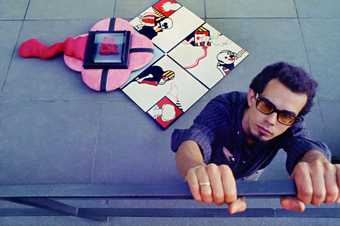Born 1944 in Campina Grande, Paraiba, Brazil. Lives and works between Rio de Janeiro and Milan, Italy.

Antonia Dias with his work Note on the Unforeseen Death in 1964
Courtesy the artist
Photo: Davis Drew Zingg
In 1957, when Antonio Dias moved to Rio de Janeiro with his family, he began working as a draughtsman and graphic designer, cultivating art as an autodidact in his spare time. In the early 1960s, Dias began frequenting the studio of Oswaldo Goeldi, the celebrated modernist printmaker, at the Escola Nacional de Belas Artes. Although Dias was grouped with the Brazilian new figuration, his practice is interwoven with the legacy of the concretist movement and the revolutionary impetus of tropicalia. While his early sculptural works contained an abstract geometric vocabulary, Dias’s training drew him to paper and canvas. In 1965 he won the painting award from the Biennale des Jeunes of Paris where he lived between 1967 and 1968. After May 1968, he was denied to have his French papers extended and decided to go to Italy, where he settled in Milan until today.
Antonio Dias’s works from the mid-1960s are distinguished by visceral red, black and white imagery, symbolic of the blood and the dirt of the urban underbelly, accentuated by the early stages of the military dictatorship in Brazil. The corporeal presence of the paintings is achieved by the addition of three-dimensional elements. Accident at the Game 1964 incorporates a protruding red phallus in the midst of stylised skulls and bones, evoking a destructive, yet deeply satirical sexuality. Note on the Unforeseen Death 1965 presents a parody of the political situation juxtaposing comical images of asphyxiating nuclear clouds, toxic gasses and soldiers with a realistic bloodstain held in the soft shrine at its centre. By borrowing elements from the structure of comics and the iconography of graffiti, Dias sabotaged commercial culture’s semiotic structure forcing viewers to confront the traumas of their environment.
Sofia Gotti
September 2015
